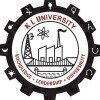Filter interviews by
Jct College Engineering Technology Interview Questions and Answers
14 Interview questions
Types of representation of numbers include decimal, binary, octal, and hexadecimal.
Decimal representation uses base 10 and consists of digits 0-9.
Binary representation uses base 2 and consists of digits 0 and 1.
Octal representation uses base 8 and consists of digits 0-7.
Hexadecimal representation uses base 16 and consists of digits 0-9 and A-F.
The two types of convolution with discrete time sequences are linear convolution and circular convolution.
Linear convolution involves summing the products of corresponding elements of two sequences over all possible values.
Circular convolution involves summing the products of corresponding elements of two sequences after wrapping around the end of the sequences.
Example: Linear convolution - [1, 2, 3] * [4, 5, 6] =...
Types of FFT include Cooley-Tukey, Radix-2, Radix-4, Split-Radix, Prime Factor, and Bluestein.
Cooley-Tukey: most common FFT algorithm, divides input into smaller DFTs
Radix-2: divides input into smaller DFTs of size 2
Radix-4: divides input into smaller DFTs of size 4
Split-Radix: combines Radix-2 and Radix-4 algorithms for efficiency
Prime Factor: decomposes DFT into smaller prime factor DFTs
Bluestein: used for arbit...
Digital Signal Processing offers advantages such as flexibility, accuracy, and ease of implementation.
Flexibility: Digital signals can be easily manipulated and processed using algorithms, allowing for more complex operations compared to analog signals.
Accuracy: Digital processing reduces noise and distortion, leading to more accurate results compared to analog processing.
Ease of implementation: Digital signal pro...
DSP in speech is used for speech recognition, noise cancellation, audio compression, and synthesis.
Speech recognition: DSP algorithms are used to analyze and recognize spoken words.
Noise cancellation: DSP techniques can remove background noise from speech signals.
Audio compression: DSP is used to compress audio data for efficient storage and transmission.
Speech synthesis: DSP algorithms can generate human-like spe...
Analog-to-Digital conversion involves sampling, quantization, and encoding of analog signals into digital form.
Sampling: capturing the analog signal at discrete time intervals
Quantization: converting the sampled values into discrete levels
Encoding: representing the quantized values in binary form
Example: In audio recording, the continuous sound wave is sampled at regular intervals, quantized into specific levels, ...
Types of digital filters include FIR filters, IIR filters, and adaptive filters.
FIR filters: Finite Impulse Response filters have a finite duration impulse response.
IIR filters: Infinite Impulse Response filters have a feedback loop in their design.
Adaptive filters: These filters adjust their parameters based on input signals to optimize performance.
Examples: Butterworth filter (IIR), Chebyshev filter (IIR), and K...
Basic elements of a Digital Signal Processing system include analog-to-digital converter, digital signal processor, memory, and input/output interfaces.
Analog-to-digital converter (ADC) - Converts analog signals into digital form for processing.
Digital signal processor (DSP) - Processes digital signals using algorithms and mathematical operations.
Memory - Stores data and instructions for processing.
Input/output in...
The two types of Fast Fourier Transform (FFT) are Cooley-Tukey FFT and Radix-2 FFT.
Cooley-Tukey FFT: Divides the DFT into smaller DFTs and recursively applies the algorithm.
Radix-2 FFT: Decomposes the DFT into smaller DFTs of size 2, which are then combined to get the final result.
Steps involved in A/D conversion
Sampling: The continuous analog signal is sampled at regular intervals.
Quantization: Each sample is assigned a digital value based on its amplitude.
Encoding: The digital values are encoded into binary format for processing.
Resolution: The number of bits used to represent each sample determines the resolution.
Conversion: The final step involves converting the digital signal into an a...
Jct College Engineering Technology Interview Experiences
3 interviews found
I applied via Walk-in and was interviewed in Aug 2023. There were 2 interview rounds.

(8 Questions)
- Q1. State the advantages of Digital Signal Processing over the analog signal processing.
- Ans.
Digital Signal Processing offers advantages such as flexibility, accuracy, and ease of implementation.
Flexibility: Digital signals can be easily manipulated and processed using algorithms, allowing for more complex operations compared to analog signals.
Accuracy: Digital processing reduces noise and distortion, leading to more accurate results compared to analog processing.
Ease of implementation: Digital signal processi...
- Q2. Mention the types of digital filters?
- Ans.
Types of digital filters include FIR filters, IIR filters, and adaptive filters.
FIR filters: Finite Impulse Response filters have a finite duration impulse response.
IIR filters: Infinite Impulse Response filters have a feedback loop in their design.
Adaptive filters: These filters adjust their parameters based on input signals to optimize performance.
Examples: Butterworth filter (IIR), Chebyshev filter (IIR), and Kalman...
- Q3. What are the types of FFT?
- Ans.
Types of FFT include Cooley-Tukey, Radix-2, Radix-4, Split-Radix, Prime Factor, and Bluestein.
Cooley-Tukey: most common FFT algorithm, divides input into smaller DFTs
Radix-2: divides input into smaller DFTs of size 2
Radix-4: divides input into smaller DFTs of size 4
Split-Radix: combines Radix-2 and Radix-4 algorithms for efficiency
Prime Factor: decomposes DFT into smaller prime factor DFTs
Bluestein: used for arbitrary ...
- Q4. What are the applns. of DSP in speech?
- Ans.
DSP in speech is used for speech recognition, noise cancellation, audio compression, and synthesis.
Speech recognition: DSP algorithms are used to analyze and recognize spoken words.
Noise cancellation: DSP techniques can remove background noise from speech signals.
Audio compression: DSP is used to compress audio data for efficient storage and transmission.
Speech synthesis: DSP algorithms can generate human-like speech f...
- Q5. What are the steps involved in Analog-to-Digital(A/D) conversion?
- Ans.
Analog-to-Digital conversion involves sampling, quantization, and encoding of analog signals into digital form.
Sampling: capturing the analog signal at discrete time intervals
Quantization: converting the sampled values into discrete levels
Encoding: representing the quantized values in binary form
Example: In audio recording, the continuous sound wave is sampled at regular intervals, quantized into specific levels, and e...
- Q6. Whata re the basic elements of Digital signal processing sysytem?
- Ans.
Basic elements of a Digital Signal Processing system include analog-to-digital converter, digital signal processor, memory, and input/output interfaces.
Analog-to-digital converter (ADC) - Converts analog signals into digital form for processing.
Digital signal processor (DSP) - Processes digital signals using algorithms and mathematical operations.
Memory - Stores data and instructions for processing.
Input/output interfa...
- Q7. Whatt are the types of representation of numbers?
- Ans.
Types of representation of numbers include decimal, binary, octal, and hexadecimal.
Decimal representation uses base 10 and consists of digits 0-9.
Binary representation uses base 2 and consists of digits 0 and 1.
Octal representation uses base 8 and consists of digits 0-7.
Hexadecimal representation uses base 16 and consists of digits 0-9 and A-F.
- Q8. What are the 2 types of convolution with discrete time sequences?
- Ans.
The two types of convolution with discrete time sequences are linear convolution and circular convolution.
Linear convolution involves summing the products of corresponding elements of two sequences over all possible values.
Circular convolution involves summing the products of corresponding elements of two sequences after wrapping around the end of the sequences.
Example: Linear convolution - [1, 2, 3] * [4, 5, 6] = [4, ...
Interview Preparation Tips
- Digital Electronics
- Signals and Systems
- Digital Signal Processing
- Communication Engg
- Electronic Circuits
- Control Sysyems
Skills evaluated in this interview

(6 Questions)
- Q1. What are the applications of DSP in speech?
- Ans.
DSP in speech is used for speech recognition, enhancement, synthesis, and compression.
Speech recognition: converting speech to text for applications like virtual assistants.
Speech enhancement: reducing noise or improving quality of speech signals.
Speech synthesis: generating human-like speech for applications like voice assistants.
Speech compression: reducing the size of speech data for efficient storage and transmissi...
- Q2. Mention the two types of Fast Fourier Transform(FFT)
- Ans.
The two types of Fast Fourier Transform (FFT) are Cooley-Tukey FFT and Radix-2 FFT.
Cooley-Tukey FFT: Divides the DFT into smaller DFTs and recursively applies the algorithm.
Radix-2 FFT: Decomposes the DFT into smaller DFTs of size 2, which are then combined to get the final result.
- Q3. What are teh steps involved in A/D conversion
- Ans.
Steps involved in A/D conversion
Sampling: The continuous analog signal is sampled at regular intervals.
Quantization: Each sample is assigned a digital value based on its amplitude.
Encoding: The digital values are encoded into binary format for processing.
Resolution: The number of bits used to represent each sample determines the resolution.
Conversion: The final step involves converting the digital signal into an analog...
- Q4. What are the types of digital filters?
- Ans.
Types of digital filters include FIR filters, IIR filters, and adaptive filters.
FIR filters: Finite Impulse Response filters have a finite impulse response, meaning they only respond to a finite duration input signal.
IIR filters: Infinite Impulse Response filters have an infinite impulse response, allowing for feedback in the filter design.
Adaptive filters: These filters adjust their parameters based on the input signa...
- Q5. What are the basic elelments of digital signal processing system?
- Ans.
Basic elements of a digital signal processing system include analog-to-digital conversion, digital filters, and signal processing algorithms.
Analog-to-digital conversion: Converts continuous analog signals into discrete digital signals for processing.
Digital filters: Used to remove unwanted noise or enhance specific frequencies in the signal.
Signal processing algorithms: Algorithms used to analyze, manipulate, and extr...
- Q6. What are the advantages of DSP over ASP?
- Ans.
DSP offers advantages such as higher precision, faster processing, and better noise reduction compared to ASP.
DSP allows for higher precision in signal processing compared to ASP
DSP can process signals faster than ASP due to specialized hardware and algorithms
DSP techniques such as filtering and noise reduction are more effective than those in ASP
DSP enables real-time processing of signals, which is crucial in applicat...
Interview Preparation Tips
Don;t guess the answer, Don;t give ananswer that could lead to further questions out of curiosity
Skills evaluated in this interview
I applied via Newspaper Ad and was interviewed before Jan 2022. There were 2 interview rounds.

(4 Questions)
- Q1. Summarize briefly the synopsis of the project-work carried out by you during PG course of study
- Ans. The project involved developing a PC-based add-on interface card for a versatile data acquisition system to convert the analog input to 12-bits of digital data and subsequent processing.
- Q2. What are the applications of Digital Signal Processing?
- Ans.
Digital Signal Processing has applications in various fields such as telecommunications, audio and video processing, radar and sonar systems, medical imaging, and speech recognition.
Telecommunications: DSP is used for signal compression, error detection and correction, and modulation and demodulation techniques.
Audio and video processing: DSP is used for audio and video compression, noise reduction, and enhancement of ...
- Q3. List some of the advantages of Digital Signal Processing over Analog Signal Processing
- Ans.
Digital Signal Processing offers advantages over Analog Signal Processing
DSP allows for greater accuracy and precision in signal processing
DSP can be easily programmed and reprogrammed for different applications
DSP can handle complex algorithms and computations more efficiently
DSP can eliminate noise and interference more effectively than analog processing
DSP can be integrated with other digital systems for seamless co...
- Q4. Define sampling in A/D conversion
- Ans.
Sampling in A/D conversion is the process of measuring and converting analog signals into digital signals at regular intervals.
Sampling involves taking discrete samples of an analog signal at regular intervals
The frequency of sampling is determined by the Nyquist-Shannon sampling theorem
The accuracy of the digital signal depends on the sampling rate and the resolution of the A/D converter
Examples of A/D conversion incl...
Interview Preparation Tips
- Digital Electronics
- Communication Engineering
- Digital Image Processing
Top trending discussions






Interview questions from similar companies

I applied via Referral and was interviewed before Feb 2023. There were 2 interview rounds.
All about previous experience
(1 Question)
- Q1. Previous salary scale
Interview Preparation Tips

I applied via Walk-in and was interviewed in Oct 2024. There was 1 interview round.
(2 Questions)
- Q1. Self Introduction
- Q2. Sales questions

I appeared for an interview in May 2025, where I was asked the following questions.
- Q1. Corizo is best
- Q2. Corizo is beat


(1 Question)
- Q1. Sql commands data types constraints

I appeared for an interview before Sep 2023.
(2 Questions)
- Q1. OOPs concept, elastic search
- Q2. Diff between read only and const
- Ans.
Read only is a keyword in C# used to restrict write access to a variable, while const is used to declare a constant value.
Read only variables can be assigned a value either at the time of declaration or in the constructor, but cannot be changed afterwards.
Const variables must be assigned a value at the time of declaration and cannot be changed throughout the program.
Read only variables are evaluated at runtime, while c...
Skills evaluated in this interview


As is and to be diagram to be crated form scenario
(3 Questions)
- Q1. About case study on the ups and downs
- Q2. About the points and missed and how to add them
- Q3. Different challenges while implementing this solutions
- Ans.
Implementing solutions can face various challenges.
Lack of resources
Resistance to change
Integration issues
Data security concerns
Training and adoption
Costs and budget constraints
Situation bsedd questions and needed to answer very specifically
Interview Preparation Tips

I applied via Walk-in and was interviewed before Oct 2023. There was 1 interview round.
(2 Questions)
- Q1. How does your experience align with the role?
- Ans.
My experience in sales includes exceeding targets, building strong client relationships, and implementing successful sales strategies.
Exceeded sales targets by 20% in my previous role
Built and maintained strong relationships with key clients, resulting in repeat business
Implemented a new sales strategy that increased revenue by 30%
- Q2. How did you achieve your targets?
Jct College Engineering Technology Interview FAQs
Tell us how to improve this page.
Interview Questions for Popular Designations
- Associate Interview Questions
- Software Developer Interview Questions
- Senior Associate Interview Questions
- Sales Executive Interview Questions
- Senior Engineer Interview Questions
- Consultant Interview Questions
- Graduate Engineer Trainee (Get) Interview Questions
- Data Analyst Interview Questions
- Show more
Overall Interview Experience Rating
based on 5 interview experiences
Difficulty level
Duration
Interview Questions from Similar Companies
Jct College Engineering Technology Reviews and Ratings
based on 20 reviews
Rating in categories
|
Assistant Professor
11
salaries
| ₹1.9 L/yr - ₹3.6 L/yr |
|
Lecturer
6
salaries
| ₹1.5 L/yr - ₹1.8 L/yr |
|
Senior Assistant Professor
6
salaries
| ₹4 L/yr - ₹4 L/yr |
|
Associate Professor
3
salaries
| ₹5 L/yr - ₹33.5 L/yr |
|
HR Trainer
3
salaries
| ₹7 L/yr - ₹8 L/yr |

ExcelR

GD Goenka Public School

Aptech

Pearson Education India
- Home >
- Interviews >
- Jct College Engineering Technology Interview Questions










